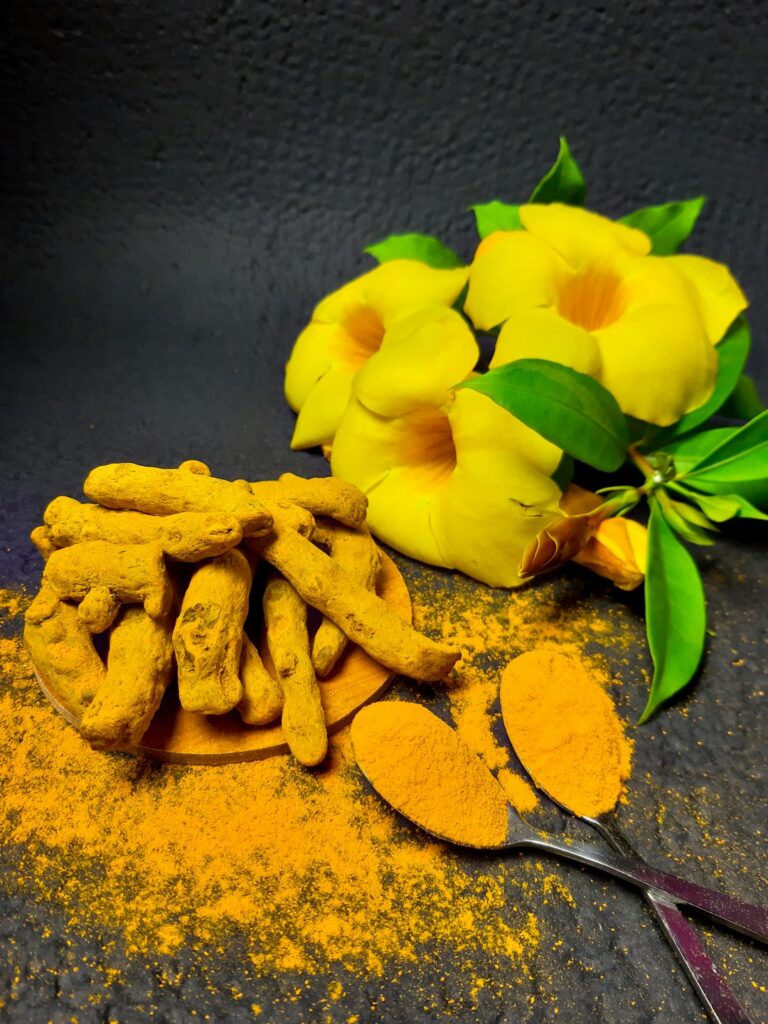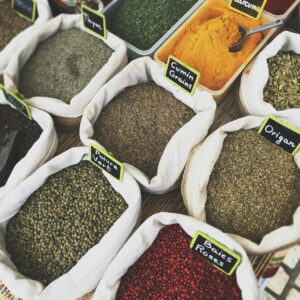Growing up with Indian parents, I was fortunate to always have turmeric in our food system. Even after my parents moved to Mexico City, the Indian community ensured that the rich tradition of spices and herbs continued by sharing and bringing them from India. At the time, I never truly appreciated the effort behind this, but now I realize it was a commitment to preserving healing traditions across borders.
Fast forward to today—turmeric has become a wellness trend. From turmeric lattes to turmeric capsules, it’s everywhere! While this is wonderful to see, how we consume turmeric is just as important as why we consume it. In Ayurveda, how you eat something matters even more than what you eat. The combinations, dosages, and preparation methods determine whether a spice serves as a healing agent or an irritant.

What is Turmeric?
Turmeric (Curcuma longa) is a bright yellow-orange root from the ginger family, traditionally used in Ayurvedic and Chinese medicine for its powerful healing properties. It has been a staple in Indian cuisine, medicine, and rituals for thousands of years.
Key Benefits of Turmeric:
✔ Powerful Anti-Inflammatory – The active compound, curcumin, helps reduce inflammation and supports joint and muscle health (Hewlings & Kalman, 2017).
✔ Supports Hormonal Balance – Aids in menopause, pre-menopause, and post-menopause by regulating inflammation and oxidative stress (Chrzanowski et al., 2021).
✔ Boosts Immunity – Naturally strengthens the body’s defense system.
✔ Enhances Digestion – Stimulates bile production, which aids in breaking down fats and detoxification.
✔ Brain & Mood Support – Shown in studies to help with cognitive function, memory, and reducing symptoms of anxiety and depression.
✔ Suppresses Fat Tissue Growth & Supports Weight Loss – Curcumin actively reduces high blood pressure, cholesterol, and blood sugar—key factors in obesity-related conditions. It also helps suppress fat tissue growth, making it a valuable addition to a balanced weight management plan.
✔ Reduces Skin Irritation & Restores Younger-Looking Skin – Studies show turmeric may help with psoriasis, acne, eczema, and premature aging by reducing inflammation and oxidative stress. While topical applications are most commonly studied, dietary consumption also promotes healthy, radiant skin.
Turmeric: The Right Dose Matters
While turmeric is incredibly beneficial, moderation is key.
- Too much turmeric can have a blood-thinning effect, which may increase the risk of bleeding if you are already taking anticoagulants.
- People with liver or bile duct disorders should avoid turmeric supplements, as it stimulates bile production.
- Research suggests that excessive turmeric consumption could negatively affect iron absorption, leading to deficiencies over time.
This is why I personally avoid turmeric supplements and prefer using it in my cooking—where it integrates naturally with other healing ingredients.

How I Use Turmeric in My Daily Life
Turmeric is an earthy spice that pairs beautifully with other herbs and spices such as cumin, coriander, garlic, and black pepper. Black pepper contains piperine, a compound that enhances the body’s absorption of curcumin. This pairing amplifies turmeric’s benefits, making it far more effective than consuming turmeric alone.
This is why cooking with turmeric is far superior to taking it in supplement form, which often lacks this essential combination. Without black pepper or piperine as its sidekick, curcumin isn’t as readily absorbed by the body.
Here are two simple and effective ways I incorporate turmeric into my family’s diet:
1️⃣ Sautéed Vegetables with Turmeric & Spices 🥦
- Add ¼ tsp of ghee to a pan.
- Sprinkle a small amount of turmeric along with other spices (cumin, coriander, black pepper).
- Toss in vegetables of choice, including spinach or green leafy vegetables, and cook lightly.
- The key? Avoid overcooking—light cooking preserves nutrients and ensures spices can penetrate deeper tissues (dhatus) in Ayurveda for maximum healing.
2️⃣ Golden Milk for Restful Sleep 🥛
- Warm a cup of organic milk (or almond milk).
- Add a dash (not spoonfuls!) of turmeric and a pinch of nutmeg/cinnamon.
- Stir well and enjoy before bedtime for deep sleep and nighttime anti-inflammatory benefits.
Bringing Ayurveda into Your Lifestyle
Turmeric is just one of many powerful Ayurvedic herbs that can enhance your vitality and well-being when used correctly. If you’re looking for personalized guidance on how to incorporate Ayurveda into your lifestyle, let’s connect!
I am a physician with 20 years of pharma experience and am passionate about introducing eastern healing practices to our western lifestyle.
📩 Contact me for a consultation and discover how to optimize your health naturally.









